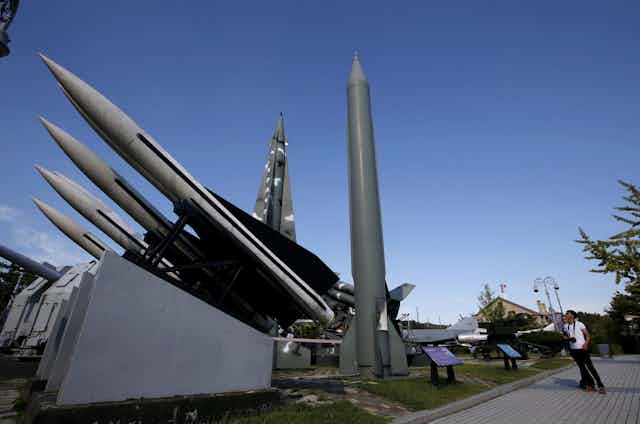The timing of North Korea’s announcement last week that it has resumed “normal operation” of its Yongbyon nuclear reactor – along with a reaffirmation of its belligerent rhetoric against the United States – might be interpreted simply as a response to Chinese President Xi Jinping’s current US state visit.
But that is not to say that it shouldn’t be taken seriously. North Korea also announced that it was preparing the launch of a long-range rocket carrying a new observational satellite. After three failed test launches of its Taepodong-2 ballistic missile, in December 2012 North Korea successfully put a satellite into orbit using a variant of this rocket design, which has a range of 5,500km. In doing so it defied a United Nations Security Council resolution barring it from developing or testing ballistic missiles.
North Korea’s activities show how even one of the world’s most impoverished and isolated countries can dramatically raise the nuclear weapons stakes. Using help from the Soviet Union more than half a century ago, a British reactor design available in the public domain and the black market nuclear network established by the developer of Pakistan’s nuclear weapons, Abdul Qadeer Khan, it has managed to produce both plutonium and highly enriched uranium, build nuclear weapons, spread nuclear reactors and weapons technology to other countries such as Syria, and increase the likelihood of regional and intercontinental nuclear conflict.
The danger of armed conflict between the two Koreas is not helped by the massive annual US-South Korea military exercises focused on the North. There is still no treaty to formalise the end of the Korean war, 62 years after it finished, and that prospect looks as distant as ever. North Korea has the world’s fourth-largest army - 1.1 million in a population of 25 million, the highest proportion of any population under arms.

Judging by the amount of plutonium it has separated from spent reactor fuel, North Korea is estimated to possess fewer than ten nuclear weapons. There is no publicly available evidence that North Korea has miniaturised its nuclear weapons or mounted them on missiles; nor has it demonstrated that it has developed the guidance and re-entry capabilities required for long-range ballistic missiles.
However, this should provide little basis for comfort. Nuclear weapons are nuclear weapons, and regrettably there are few more effective ways for the North Korean regime to demand political attention than to produce, test and threaten to use them.
Even if it lacks a proven capacity to deliver nuclear warheads on long-range missiles, North Korea could deliver a nuclear weapon almost anywhere, for example by using a shipping container or small submarine. North Korea also poses a nuclear threat through its extensive investment in cyber-warfare capacity.
This capacity may have been demonstrated last December, when North Korea is believed to have been behind the hacking of Sony Pictures before the planned release of The Interview, a comedy film about a plot to assassinate North Korean leader Kim Jong-un. It might seek to emulate the Israel-US cyberattack that infiltrated specific software on secure, non-internet-connected computers at Iran’s Natanz nuclear facility, causing its uranium-enrichment centrifuges to malfunction and be destroyed.
A credible global threat?
Much of this is necessarily speculative, but it is important to draw the right lessons from the security threat that North Korea poses even with less than 0.1% of the world’s nuclear weapons. Australian foreign affairs documents, revealed under Freedom of Information last week, show how the Australian government continues to use North Korea as a principal justification for its own reliance on US nuclear weapons, and to block global efforts to prohibit and eliminate nuclear weapons.
Australia refuses to support the position that nuclear weapons should never be used again under any circumstances. It is not among the 117 nations that have signed the Humanitarian Pledge, committing to cooperate “in efforts to stigmatise, prohibit and eliminate nuclear weapons in light of their unacceptable humanitarian consequences”, and undertaking “to fill the legal gap for the prohibition and elimination of nuclear weapons”.
Instead, Australia has pushed weak counter-proposals. It continues to call for steps dependent on the nuclear-armed states and which have been stalled for decades, despite admitting “bleak prospects for progress in multilateral arms control in the next few years”. While it claims to support nuclear disarmament, there is little concrete evidence that Australia is willing to relinquish the immoral and inconsistent position of having the threat of US nuclear weapons used on its behalf.
Yet this only perpetuates and escalates the cycle of nuclear threat and proliferation. How can Australia, facing no conceivable military threat other than that posed by its military and nuclear alliance with the US, deny North Korea (or any other country) the same misguided aspiration for nuclear “protection”?
The right lessons to take from North Korea’s nuclear belligerence are that nuclear weapons threaten the security of all nations, even those that possess them, and that nuclear double standards are a recipe for proliferation, not disarmament. Continuing to point nuclear weapons at North Korea while asking them not to point them back obviously won’t work.
For biological and chemical weapons, anti-personnel landmines and cluster munitions, a clear treaty prohibition paved the way for their progressive elimination. Establishing a clear moral, political and legal norm against these indiscriminate and inhumane weapons has drastically reduced their use and influenced even countries not signed up to the relevant treaty. Yet the nuclear-armed states show no intent of fulfilling their legally binding obligation to disarm.
Indeed, all are investing massively in modernising their nuclear arsenals. That is why states without the weapons need to take the lead and start negotiations that are open to all states but blockable by none, for a global treaty to prohibit nuclear weapons and provide for their verifiable elimination from the arsenals of all nations.

